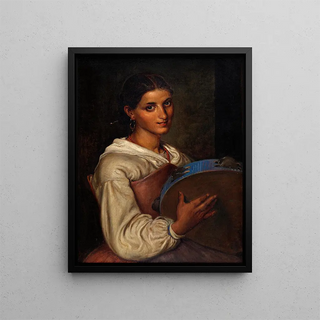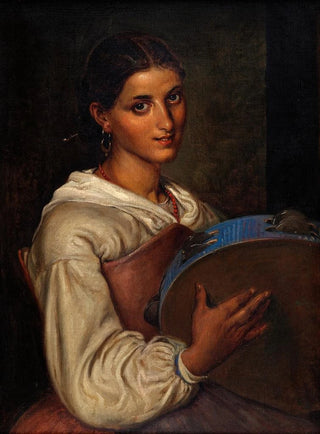Art print | Italian girl with a blue tambourine - Wilhelm Marstrand


View from behind

Frame (optional)
Art print of Italian girl with a tambourine in blue - Wilhelm Marstrand – Captivating introduction
In the fascinating universe of art, some works manage to capture the essence of a particular era, culture, and human emotions with such intensity that they become essential references. "Italian girl with a blue tambourine" by Wilhelm Marstrand is one of these creations. This painting not only evokes the beauty of a young woman but also a vibrant atmosphere, full of life and melody. Through this work, the Danish artist succeeds in transporting us to a world where music and tradition meet, inviting us to explore the richness of Italian culture.
Style and uniqueness of the work
Marstrand's style is imbued with a sensitivity that is uniquely his own. In "Italian girl with a blue tambourine," he deploys a palette of delicate colors, where shades of blue blend harmoniously with the warm tones of the protagonist's clothing. This chromatic choice is no coincidence; it symbolizes both freshness and vitality of youth, while also evoking the sky and sea surrounding Italy. The posture of the young girl, light and graceful, demonstrates undeniable mastery of anatomy and movement. Marstrand manages to capture a fleeting moment, the one where dance and music converge, creating an almost palpable dynamic. The texture of the clothing, rendered with precision, adds a tactile dimension to the work, inviting the viewer to feel the authenticity of the scene.
The artist and his influence
Wilhelm Marstrand, born in 1810, is an artist whose work is often marked by his travels and encounters with other cultures. His stay in Italy profoundly influenced his art, allowing him to incorporate elements of Italian daily life into his compositions. Marstrand is recognized for his ability to blend romanticism with touches of realism, thus offering a unique vision of his subjects. Inspired by scenes of popular life, he manages to immortalize moments of joy and simplicity, demonstrating sensitivity towards people's everyday lives. His influence is not limited to his time, as his works continue to

Matte finish

View from behind

Frame (optional)
Art print of Italian girl with a tambourine in blue - Wilhelm Marstrand – Captivating introduction
In the fascinating universe of art, some works manage to capture the essence of a particular era, culture, and human emotions with such intensity that they become essential references. "Italian girl with a blue tambourine" by Wilhelm Marstrand is one of these creations. This painting not only evokes the beauty of a young woman but also a vibrant atmosphere, full of life and melody. Through this work, the Danish artist succeeds in transporting us to a world where music and tradition meet, inviting us to explore the richness of Italian culture.
Style and uniqueness of the work
Marstrand's style is imbued with a sensitivity that is uniquely his own. In "Italian girl with a blue tambourine," he deploys a palette of delicate colors, where shades of blue blend harmoniously with the warm tones of the protagonist's clothing. This chromatic choice is no coincidence; it symbolizes both freshness and vitality of youth, while also evoking the sky and sea surrounding Italy. The posture of the young girl, light and graceful, demonstrates undeniable mastery of anatomy and movement. Marstrand manages to capture a fleeting moment, the one where dance and music converge, creating an almost palpable dynamic. The texture of the clothing, rendered with precision, adds a tactile dimension to the work, inviting the viewer to feel the authenticity of the scene.
The artist and his influence
Wilhelm Marstrand, born in 1810, is an artist whose work is often marked by his travels and encounters with other cultures. His stay in Italy profoundly influenced his art, allowing him to incorporate elements of Italian daily life into his compositions. Marstrand is recognized for his ability to blend romanticism with touches of realism, thus offering a unique vision of his subjects. Inspired by scenes of popular life, he manages to immortalize moments of joy and simplicity, demonstrating sensitivity towards people's everyday lives. His influence is not limited to his time, as his works continue to






